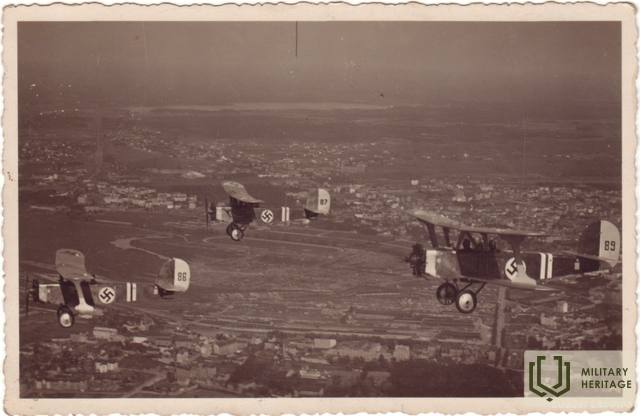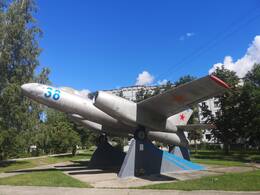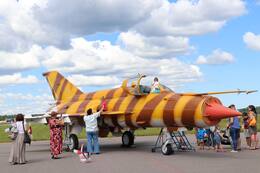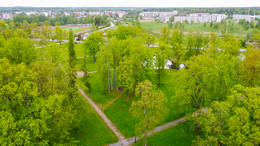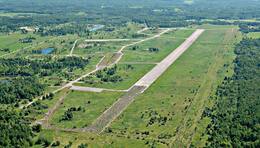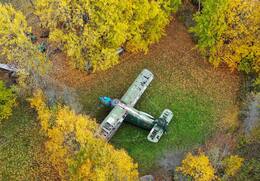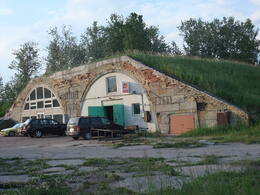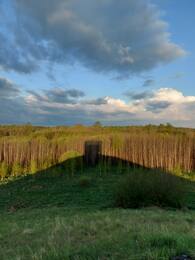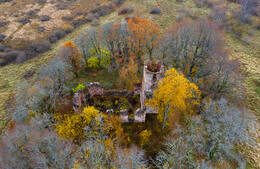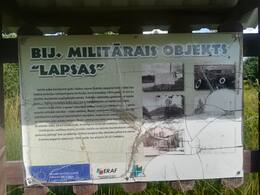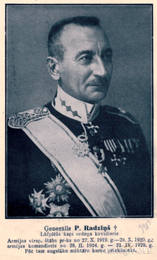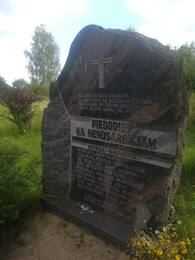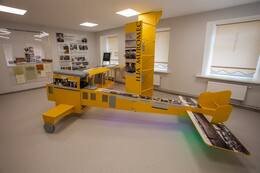Karinė aviacija
I WW1, I Nepriklausomybės karai, Baltijos šalių nepriklausomybė, II WW2, IV Sovietų okupacija, Atkurta Nepriklausomybė

1918 m. gruodžio pradžioje paskelbus Latvijos valstybę, buvo pradėtos formuoti Latvijos ginkluotosios pajėgos.
1919 m. birželio 7 d. buvo įkurtas Latvijos ginkluotųjų pajėgų aviacijos parkas (šūkis — „Viskas Latvijai!“), o pirmuoju jo vadu tapo Alfredas Valeika. 1921 metais Aviacijos parkas buvo pertvarkytas į Aviacijos diviziją, o 1926 metų rugsėjo 18 dieną – į Aviacijos pulką.
1919–1940 metais Latvijos karo aviacija tapo stipriausia Baltijos šalyse. Tuo metu Latvijos aviacija orlaivius gamino savo gamykloje VEF ir Liepojos jūrų uosto cechuose. Taip pat buvo lėktuvų iš Europos, daugiausia iš Anglijos. Aviacijos pulką sudarė naikintuvų eskadrilės, žvalgybinių lėktuvų eskadrilės, karinio jūrų laivyno aviacijos eskadrilė ir aviacijos mokyklos padalinys, rengęs pilotus ir specialistus visoms reikalingoms tarnyboms. 1939 m. Aviacijos pulkui priklausė: pulko štabas Rygoje, 8 operatyvinės eskadrilės (60 lėktuvų, 120 lakūnų ir 80 specialistų), Karo aviacijos mokykla, remonto dirbtuvės, tiekimo depas.
Aviacijos pulkas oficialiai nustojo egzistavęs 1940 m. gruodžio 25 d., SSRS okupavus Latviją.
Latvijai atgavus nepriklausomybę, prasidėjo ir Latvijos gynybos pajėgų atkūrimas. 1992 metų vasario 24 dieną Gynybos pajėgų štabe buvo įkurta Oro ir oro gynybos direkcija, kuri vėliau buvo pertvarkyta į Karinių oro pajėgų štabus. 1992 m. birželio 17 d. gynybos ministras pasirašė įsakymą dėl karinių oro pajėgų atkūrimo.
Daugiau informacijos šaltinių
Šaltiniai:
https://www.mil.lv/lv/vienibas/gaisa-speki
Susijusios vietos
Pagalvės oro uostas
Įsikūręs Rygoje, Pārdaugavoje, Spilvės pievose netoli Iļģuciems.
Spilvė karinio paveldo istorijoje garsėja ambicingu Spilvės mūšiu XVIII a. ir Spilvės aerodromas. Nuo XX amžiaus jis buvo naudojamas orlaivių bandymams, o Pirmojo pasaulinio karo metais tapo Latvijos aviacijos istorijos liudininku.
Pirmojo pasaulinio karo metais Spilvės pievas naudojo Rusijos kariuomenės oro pajėgos kovoje su vokiečių kariuomene. Sukūrus Latviją, aerodromas tapo svarbiausia šalies oro pajėgų baze ir pilotų poligonu. Ankstesni oro uosto pavadinimai buvo „Spilvės oro uostas“ arba „Rygos oro uostas“, vėliau „Rygos centrinis oro uostas“. Tai buvo pagrindinis oro uostas Latvijoje iki Rygos oro uosto atidarymo 1975 m.
Galbūt prie įspūdingų ne vieno Latvijos piloto pasiekimų prisidėjo prie Rygos esantis Spilvės aerodromas ir svajonė pasiekti žvaigždes. Galbūt, tačiau Latvijos aviacijos užuomazga gerokai senesnė ir ją galima rasti Priekulėje, kur latvių kalvis Zviedris savadarbiu aparatu išskrido iš bažnyčios bokšto.
Šiandien Spilvės oro uostas veikia. Galima pamatyti 1954 metais pastatytą oro uosto pastatą, kuris įkūnija sovietinį klasicizmą arba „Stalino imperijos“ stilių.
Šaltiniai:
Irbītis, K. Latvijos aviacija ir jos pradininkai. Ryga: Mokslas, 2004.
Brūvelis, E. Latvijos aviacijos istorija: 1919-1940. Ryga: Mokslas, 2003.
Oficiali valstybinės agentūros „Civilinės aviacijos agentūra“ svetainė. Prieiga: https://www.caa.gov.lv/lv/latvijas-aviacijas-vesture-isuma [žiūrėta 2021 02 22].
Rygos oro muziejus (Rygos aviacijos muziejus)
Rygos aviacijos muziejus yra Skultės kaime, Marupės savivaldybėje, Rygos oro uosto teritorijoje, šalia orlaivių stebėjimo aikštelės. Tai privatus turistinis objektas, atidarytas 1997 m. Šiai kolekcijai sukurti prireikė daugiau nei 50 metų. Aviacijos įranga surinkta iš Latvijos, Rusijos, Lenkijos, Ukrainos, Čekijos ir JAV. Tai viena didžiausių ir vertingiausių kolekcijų Europoje. Latvijos aviacijos muziejaus idėja kilo mažiausiai prieš 80 metų. Latvijos aviacijos istorija siekia laikus, kai buvo kuriami pirmieji pasaulyje orlaiviai. Latvijos pilotai buvo tarp tų, kurie dalyvavo siekiant daugelio pasaulio rekordų. Po Pirmojo pasaulinio karo ir Latvijos nepriklausomybės karo Latvijos armija pradėjo formuoti oro pajėgas, todėl iškilo poreikis išsaugoti istorinius įrodymus. Ketvirtajame dešimtmetyje atsirado galimybė pradėti kurti muziejų. Jis jau buvo įgijęs ypač vertingų istorinių eksponatų savo kolekcijoje. Antrasis pasaulinis karas sužlugdė šį projektą ir kolekcija buvo prarasta. Šiandien muziejuje yra apie 40 orlaivių, daugiausia pagamintų Sovietų Sąjungoje. O ekspozicija suteikia įžvalgų apie sovietinės aviacijos istoriją.
IL-28 orlaivio skulptūra
Įsikūręs Skultės kaime, Marupės savivaldybėje, netoli Rygos tarptautinio oro uosto.
Skultė buvo vienas iš pavyzdinių kaimų, sukurtų sovietų kariškiams. Jame buvo dislokuotas aviacijos dalinys, kuris 1941 m. bombardavo Berlyną ir kitus miestus, taip pat dalyvavo Baltijos šalių okupacijoje. 1978 m. jame buvo įrengtas aplinkosaugos objektas – lėktuvas IL-28, skirtas pagerbti sovietų armijos pilotų nuopelnus Antrajame pasauliniame kare.
Po karo Sovietų Sąjunga tęsė aktyvią ginkluotės politiką. IL-28 buvo pirmasis, plačiausiai gaminamas sovietinis reaktyvinis bombonešis. Pirmoji serijinė atominė bomba RDS-4 („Tatjana“) buvo pagaminta iš to paties modelio 1953 m., siekiant patikrinti armijos gebėjimą pradėti ataką po branduolinio sprogimo. Lėktuvas turėjo įvairių modifikacijų. Bandymų metu jis pasiekė 906 km/h greitį, gabeno kelias tonas krovinio ir atliko 2445 km skrydį. Jį pilotavo 3 žmonių įgula.
Lėktuvas yra ne tik karinio paveldo liudininkas, bet ir ideologijos simbolis. 2010 m., minint Sovietų armijos pergalę prieš Vokietiją, lėktuvas buvo restauruotas. Taip pat buvo keletas nesėkmingų bandymų jį išardyti kaip objektą, šlovinantį Latvijos okupacinį režimą. Tai pavyko 2022 m., kai lėktuvas buvo perkeltas.
Šiuo metu orlaivį galima apžiūrėti netoliese esančiame Rygos aviacijos muziejuje Skultėje, taip pat susidaryti vaizdą apie sovietinės armijos kariškiams pastatytą kaimelį.
Aviacijos muziejus „SKY ZOO“
Aviacijos muziejus „Sky Zoo“ yra Smārdės valsčiuje, Tukumo savivaldybėje, Jūrmalos oro uosto teritorijoje, kuri anksčiau buvo Tukumo karinis aerodromas. Ekspozicijoje eksponuojami lėktuvai YAK-40, AN-2, SU22M4, PZL TS-11 Iskra ir sraigtasparnis MI-24. Ekskursijos po aerodromą metu apžiūrimi angarai, kaponieriai ir inžinerinė įranga. Aerodromą naudojo tiek Vokietijos, tiek Sovietų Sąjungos armijos. Sovietų okupacijos metu tai buvo vienas svarbiausių karinių aerodromų Latvijos teritorijoje. Jame dislokuoti naikintuvai buvo skirti atakuoti priešo laivus ir bombarduoti pakrantės įtvirtinimus. 1975 m. lapkričio 9 d. naktį Tukumo aerodrome buvo gautas kovos signalas – Sovietų Sąjungos teritoriniuose vandenyse (Rygos įlankoje) buvo priešo karo laivas, kurį reikėjo sunaikinti. Iš Tukumo pakilo keli lėktuvai. Tačiau paaiškėjo, kad ginkluotas maištas prieš esamą sovietų režimą įvyko sovietų karinio jūrų laivyno karo laive „Storoževoi“ („Globėjas“). Lėktuvams pasiekus karo laivą, mūšis dar tęsėsi. Vėliau sukilėlių vadas Valerijus Sablinas, sovietų karinio jūrų laivyno karininkas, buvo sužeistas, o maištas baigėsi. Jam buvo skirta mirties bausmė už išdavystę. Tai buvo vienas dramatiškiausių įvykių, rodančių nepasitenkinimą režimu ir žyminčių artėjantį jo žlugimą.
Latvijos karinės aviacijos oro uostas
Įsikūręs Vecgulbenės dvaro teritorijoje – istoriniame centre.
Tarpukariu Gulbenėje buvo įsikūręs Latvijos armijos garnizonas, kuriame buvo dislokuotas 7-asis Siguldos pėstininkų pulko batalionas. Ketvirtojo dešimtmečio viduryje pradėta kurti karinė aviacijos bazė, nes sėkmingam karinės aviacijos veikimui net taikos metu turi būti užtikrintas platus aerodromų tinklas. Aerodromai ypač svarbūs tose vietose, kur įkurtos svarbios geležinkelio ir kelių sankryžos. 1935 m. lapkričio 11 d. čia pradėtas karinio aerodromo statymas. 1937 m. Gulbenėje buvo dislokuotas naujai suformuotas Aviacijos pulko dalinys, kuris tapo 6-uoju Latgalos divizijos žvalgybos eskadrile, padidindamas armijos dalinių skaičių prie rytinės Latvijos sienos.
Matosi oranžerijos pastatas.
Vainodės oro bazė
Vainodės aerodrome vis dar yra 16 sovietmečio orlaivių angarų ir 1800 m ilgio kadaise 2500 m ilgio tako atkarpa. Aerodromą galima aplankyti tik iš anksto užsiregistravus. Vainodės aerodromas buvo įkurtas Latvijos nepriklausomybės metais kaip vienas iš Latvijos aviacijos lopšių, o vėliau tapo vienu didžiausių karinių aerodromų Baltijos šalyse. 1916 m. buvo pastatyti du angarai Vokietijos armijos dirižabliams. Dirižabliai buvo naudojami žvalgybai rinkti ir Rusijos armijos pozicijoms bombarduoti. Vėliau Rygos miestas įsigijo dirižablių angarus ir panaudojo jų stogo konstrukcijas Rygos centrinio turgaus paviljonams pastatyti. 1940 m. gegužę į Vainodę persikėlė 31-asis Raudonosios armijos greitųjų bombonešių aviacijos pulkas ir pradėta standartizuoto betoninių plokščių tako statyba. 1944 m. vasaros pabaigoje nebaigtu aerodromu naudojosi įvairūs vokiečių aviacijos daliniai, tačiau Antrojo pasaulinio karo pabaigoje tą patį aerodromą naudojo Raudonosios armijos aviacijos daliniai, kovoję su vokiečių armijos grupuote „Kurzeme“. Po Antrojo pasaulinio karo Sovietų Sąjungos oro pajėgos Vainiodėje buvo dislokuotos iki 1992 m.
Rumbulos oro bazė
Įsikūręs Rygos pietryčiuose, Rumbuloje, tarp Maskavas gatvės ir Dauguvos upės.
Rumbuloje buvo Sovietų armijos karinių oro pajėgų bazė ir civilinis oro uostas šalia pagrindinio Rygos oro uosto Spilvėje. Abu oro uostai egzistavo iki Rygos oro uosto atidarymo. Prieš Antrąjį pasaulinį karą ir Latvijos okupaciją Rumbuloje buvo Latvijos armijos aviacijos pulko aerodromas.
Po Antrojo pasaulinio karo Sovietų Sąjunga pradėjo gaminti reaktyvinius orlaivius, kuriems reikėjo ilgesnių ir lygesnių kilimo ir tūpimo takų. Seni aerodromai buvo plečiami ir statomi nauji. Besikeičiančios oro sąlygos Baltijos šalyse ir trumpas pirmųjų reaktyvinių lėktuvų skrydžio laikas buvo daugelio atsarginių aerodromų sukūrimo priežastis. Reaktyvinių lėktuvų triukšmas sukėlė Rygos gyventojų nepasitenkinimą, nes karinis aerodromas buvo per arti gyvenamųjų rajonų ir galėjo sukelti pavojingas situacijas. 1973 m. jis buvo uždarytas, o jo vietoje pastatytas Lielvārdės aerodromas, į kurį buvo perkelti koviniai lėktuvai. Netrukus prieš uždarymą kilo tarptautinis skandalas. Ten buvo sumuštas JAV oro pajėgų karininkas, kuris buvo vienas iš karinių atašė Maskvoje. Įtariama, kad jį užpuolė 14–20 oro uosto darbuotojų, įtarusių, kad aerodromas yra fotografuojamas.
Šiandien galite aplankyti apleistą aerodromo teritoriją.
Sovietų oro pajėgų taikinių šaudymo vieta Zvarde
Zvārdės poligonas yra Zvārdės savivaldybėje, Saldaus rajone. Tai buvęs SSRS karinės aviacijos poligonas, užimantis daugiau nei 24 000 hektarų.
Buvusio aerodromo teritorijoje yra keletas objektų: Karininkų kurganas, Zvārdės ir Ķērklinių bažnyčių griuvėsiai, Rītelių kapinės, buvusi kariuomenės bazė „Lapsas“ ir kiti. Iki Antrojo pasaulinio karo apžvalgos bokšto vietoje stovėjo „Vairogų“ namas. Statant poligoną, tai, kas liko iš ūkio – sienos, obelyno liekanos ir dalis Veczvārdės dvaro griuvėsių – buvo sukrauta į pylimą, o ant jo pastatytas apžvalgos bokštas. Jis buvo naudojamas kaip apžvalgos aikštelė kariuomenės mokomiesiems manevrams koordinuoti. Ši vieta populiariai vadinama kurganu. Nuo piliakalnio atsiveria vaizdas į buvusį poligoną ir Zvardės gamtos parko bei gamtos rezervato miškingas vietoves. Gera vieta stebėti paukščius. Kurgano apylinkės nėra apželdintos.
Ķerklinių bažnyčios griuvėsiai
Kerklinių bažnyčios griuvėsiai yra apie 5 kilometrus į šiaurės vakarus nuo Kokmuižos, netoli Kerklinių ežero. Bažnyčią 1641 m. pastatė Kerklinių dvaro savininkas Heinrichas fon Dönhoffas (Derkartas). Originali medinė bažnyčia buvo pakeista akmeniniu pastatu, po kuriuo buvo įrengti kapai Dönhofų, o vėliau Kleistų šeimų mirusiesiems. Kapai jau buvo sunaikinti per 1905 m. riaušes, tačiau 1949 m. karstai iš kapų buvo perkelti į bažnyčią. Bažnyčia buvo Kuržemės baroko stiliaus pavyzdys – jos drožinius sukūrė Kuldygos ir Liepojos medžio drožėjai. Nors dvaro ir bažnyčios savininkai įvairiais laikais susidūrė su finansinėmis problemomis, per savo gyvavimo laikotarpį bažnyčia buvo kelis kartus rekonstruota. Ji taip pat nukentėjo per Pirmąjį pasaulinį karą, po kurio parapija 1929 m. atstatė mūrą, o 1934 m. pridėjo vargonus. Deja, per Antrąjį pasaulinį karą bažnyčia buvo apgadinta ir didelė jos dalis buvo prarasta, todėl reikia pagirti, kad iki bažnyčios atstatymo 1933 m. daugelis unikalių baroko skulptūrų buvo nufotografuotos, suinventorizuota ir netgi atsidūrė Paminklų valdybos archyve. Įkūrus sąvartyną ir iškeldinus gyventojus, bažnyčia niekada nebuvo restauruota. Šiandien matomos bažnyčios sienos ir bokštas.
Zvārdės šaudykla ir buvusi sovietų karinė bazė „Lapsas“
Poligono aptarnavimo bazė yra maždaug 2 kilometrus į rytus nuo Strikių dvaro, prie Saldus-Auce kelio. Į pietus nuo Saldus yra buvęs sovietų karinės aviacijos taikinių poligonas (karinis dalinys Nr. 15439) Zvārdėje. Aerodromo teritorijoje yra keletas lankytinų vietų – Zvārdės ir Ķerklinių bažnyčių griuvėsiai, sugriautos Rītelių kapinės, aerodromo stebėjimo postas, vadinamasis „Karininkų kurganas“ ir buvusi aerodromo personalo bazė bei šaudykla „Lapsas“.
Zvārdės oro taikinių poligonui aptarnauti – taikiniams įrengti, pažeidimams taisyti, oro taikinių poligonui saugoti ir oro skrydžiams koordinuoti – reikėjo maždaug vienos kuopos dalinio. Iki Antrojo pasaulinio karo jis buvo įsikūręs namo, vadinamo „Lapsas“, vietoje. Pastačius aerodromą, buvo pastatytos kareivinės, transporto depo, skrydžių valdymo bokštas ir šaudykla mokomajam personalui.
Latvijai atgavus nepriklausomybę, čia veikė Zvārdės gynybos pajėgų mokymo centras, tačiau nuo 2007 m. ši vieta priklauso savivaldybei ir ją nuomoja keli medžiotojų kolektyvai. Buvusiose kareivinėse įrengta ekspozicija apie Zvardės parapijos istoriją.
Sovietų armijos apžvalgos bokštas (Karininkų kurganas)
„Karininkų kurganas“ yra mažiau nei už kilometro nuo Zvārdės bažnyčios griuvėsių. Kurganas sudarytas iš aplinkinių namų ir dvaro rūmų griuvėsių ir liekanų, kurios buvo suverstos buldozeriais. Ant kurgano pastatytas stebėjimo bokštas. Remiantis užrašu, dabartinis bokštas buvo pastatytas 1981 m. Bokštas buvo naudojamas bombų pataikymams registruoti. Mokomosiose bombose buvo sumažintas sprogstamosios medžiagos kiekis, todėl jų pataikymus reikėjo stebėti atidžiau. Nesprogusios bombos buvo nedelsiant neutralizuotos, tačiau ne visas pavyko rasti.
Šiandien čia galima pamatyti bokšto liekanas – plytų sienas. Kadangi užtvanka yra gana aukšta, giedrą dieną Mažeikiuose galima pamatyti net Lietuvos naftos perdirbimo gamyklą.
Generolo Pēterio Radziņa memorialinė vieta
Įsikūręs Valkos valsčiuje, važiuojant keliu Valka–Rūjiena (P22) 4 kilometre, pasukite į dešinę, sekant nuorodas.
Pēteris Radziņš gimė 1880 m. gegužės 2 d. Lugažių parapijos „Jaunvīndedzēs“. Mokėsi Lugažių parapijos mokykloje, Valkos miesto mokykloje ir Valkos Nelsono realinėje mokykloje. Savanoriu įstojo į Rusijos armiją. 1919 m. rudenį grįžo į Latviją ir spalio 27 d. buvo paskirtas Vyriausiojo armijos vado štabo viršininku, šias pareigas užimdamas tuo metu, kai bermontininkai kėlė grėsmę Rygai. Būdamas štabo viršininku, jis vadovavo visiems mūšiams Rygoje, Žiemgaloje ir Latgaloje. 1920 m. vasario 5 d. buvo paaukštintas generolu.
Šiandien šalia šeimos namų galima pamatyti generolui Pēteriui Radzinšui (1880–1930) skirtą atminimo akmenį.
2017 m. lapkričio 11 d. Rygoje, Dauguvos vartų kampe, buvo atidengta memorialinė lenta Pēteriui Radžiniui.
Vaizdo įrašas: Generolo P. Radzinio atminimo renginys Rygos brolių kapinėse 2019 m.
Vaizdo įrašas: 2019 m. gegužės 2 d., minint generolo Pēterio Radzinio 139-ąsias gimimo metines, Lapkričio 11-osios krantinėje, netoli Prezidento rūmų, vyko atminimo renginys, kuriame garbės sargybos stulpai ir susidomėję asmenys apsupo atminimo lentą.
Valkos kraštotyros muziejaus ekspozicijoje „Valka – Latvijos nepriklausomybės lopšys“ taip pat atsispindi generolo Pēterio Radzinio gyvenimas ir veikla.
Be tradicinių kolekcijos eksponavimo būdų, parodoje naudojami interaktyvūs multimedijos sprendimai. Informacija ir anotacijos verčiamos į estų ir anglų kalbas.
Rygos centrinio turgaus cepelinų angarai
Įsikūręs Rygos centre, priešais Rygos tarptautinę autobusų stotį, netoli Rygos geležinkelio keleivių stoties.
Rygos centrinis turgus yra didžiausias turgus Latvijoje, kadaise laikytas geriausiu ir moderniausiu turgumi Europoje. Ryškiausias jo simbolis – 1920-aisiais pastatyti turgaus paviljonai, kurie iš pradžių buvo naudojami kariniams tikslams.
Pirmojo pasaulinio karo metu Vokietijos armija Kuržemėje įkūrė Vainodės oro uostą, kuriame nuolat buvo dislokuoti keli dirižabliai. Tai buvo pailgi balionai, pripildyti dujų, su prie korpusų pritvirtintomis patalpomis keleiviams ir kroviniams gabenti. Valdymą užtikrino vidaus degimo arba elektrinis variklis ir sparnas korpuse. Dirižabliai buvo skirti žvalgybai arba priešo bombardavimui, pavyzdžiui, jie vykdė ataką prieš Rusijos armijos hidroplanų aerodromą netoli Ronių salos. Yra žinoma, kad angarai buvo vadinami „Walhalla“ ir „Walther“.
Po Latvijos nepriklausomybės karo angarai buvo išardyti ir panaudoti Rygos centrinio turgaus angarų statybai, ketinant palikti juos originaliuose matmenyse. Vėliau buvo nuspręsta naudoti tik viršutines angarų dalis.
Šiandien galite apžiūrėti Vokietijos armijos dirižablių angaro metalines konstrukcijas. Turgus leidžia maloniai susipažinti su pasaulinės aviacijos pradžios įrodymais. Ekskursijų užsakymas: +37167358157; gints.aksiks@rct.lv.
Riteli Cemetery
After the airfield was established in this area in 1953 at the request of the USSR Ministry of Defence, the Zvārde Church, the Ķerkliņi Church and the Rīteļi Cemetery were actually located in the centre of the airfield - next to an artificial airfield with access roads and defence positions, which was used as a target by Soviet pilots. Planes flew here from airfields in Latvia and elsewhere in the Soviet Union. In less than 40 years, the church, the cemetery, the former manor house and dozens of surrounding buildings were reduced to ruins. Today, the site is cared for by the Saldus Martin Luther Church. The surrounding area is still contaminated with unexploded ordnance and it can be dangerous to walk off the roads.
Barbarism reached its peak in 1988, when the Rīteļi cemetery with its graves and monuments was bulldozed.
On 21 July 1990, in one of the first actions in which the Latvian population demanded that the USSR army leave the territory of Zvārde, a protest rally was held in Saldus, after which people went to the Rīteļi cemetery. The rally participants were allowed into the landfill site, and they cleaned up the cemetery a bit and dug white crosses.
The landfill continued to be used until 1992 and even as late as March 1992 a plane taking off from Lielvārde crashed in the landfill for unknown reasons. The Latvian Defence Forces started demining the site in May 1993, after the withdrawal of the Russian army. In 2008, Zvārde residents installed a memorial stone "Forgive us for not saving you" in the Rīteļi cemetery.
Preilių istorijos ir taikomosios dailės muziejaus ekspozicija „Jazepas Baško – vežėjas oru“ (Jāzeps Baško – gaisa fūrmanis)
Ekspozicija „Jazepas Baško – vežėjas oru“ skirta lakūnui, eska drilės „Iļja Muromec“ vadui ir Latvijos karinių oro pajėgų orga nizatoriui, generolui Jazepo Baško, minint jo 125-ąsias gimimo metines bei Pirmojo pasaulinio karo 100-metį. Muziejaus fonduose saugoma ekspozicija – tai ir dizaino objektas: šešis kartus sumažintas lėktuvo „Ilja Muromec“ ma ketas, su kuriuo pateikiama informacija tekstų ir vaizdų pavi dalu. Paroda papildyta Latvijos karo muziejaus eksponatais ir nauja archyvine medžiaga, gauta iš Latvijos valstybinio istorijos archyvo, Spilvės aviacijos muziejaus ir privačių asme nų archyvų. Jazepas Baško pelnytai laikomas vienu labiausiai apdovano tų latvių lakūnų ir vienu iš pasaulinės aviacijos pradininkų.
Su lėktuvu „Ilja Muromec“ jis pasiekė keturis pasaulio aviacijos rekordus, o jo pavardė įrašyta į Louis Blériot Garbės knygą Paryžiuje – geriausių pasaulio lakūnų sąrašą. Jazepas Baško buvo apdovanotas visais tuometės carinės Rusijos ordinais, taip pat Latvijoje – Trijų žvaigždžių 3-iojo laips nio ordinu, Viesturo 2-ojo laipsnio ordinu, Gynėjų nuopelnų kryžiumi bei aukščiausiais Čekoslovakijos, Estijos, Suomijos ir Lenkijos apdovanojimais. Jis tarnavo carinės Rusijos kariuomenėje, bolševikų Raudo nojoje armijoje, o nuo 1921 m. – Latvijos kariuomenėje. Po Latvijos okupacijos buvo atleistas iš tarnybos
Zoknių aerodromas
Šiaulių miesto dalyje, vadinamoje Zokniais, nuo tarpukario laikų veikė aerodromas, vėliau tapęs oro uostu.
1931 m. Zokniuose nuspręsta įkurti aerodromą, lygūs laukai ir žvyruotas gruntas puikiai tiko lėktuvams. Birželio 1 d. iš Kauno į Zoknius perkelta 3-oji ir 4-oji žvalgybos eskadrilės, kurioms priklausė lėktuvai LVG C.VI ir Albatros C.XV. Buvo pastatyti angarai, štabo pastatas ir kareivinės, o pirmuoju bazės viršininku tapo majoras Leonardas Peseckas.
Augant Lietuvos karo aviacijos pajėgumams, Zoknių aerodromas plėtėsi: čia buvo pastatyti nauji angarai, lėktuvų remonto dirbtuvės, įkurtas poligonas bombų mėtymui netoli Šilėnų. 1937 m. į Zoknius buvo perkelta 5-oji eskadrilė su naikintuvais „Letov Š-20“ ir FIAT C.R.20, o 1938 m. šiuos senus naikintuvus pakeitė modernūs Gloster Gladiator, pasižymėję puikiais rezultatais Suomijos–SSRS (Žiemos) kare.
1936 m., vykdant S. Raštikio kariuomenės reformas, karo aviacija buvo decentralizuota, o Zoknių aerodromas tapo viena iš pagrindinių šalies karinių bazių. Karo aviacijos pajėgos čia plėtėsi, įsteigtos aviacinės dirbtuvės, kurios prisidėjo prie lėktuvų priežiūros ir remonto, o vėliau jose dirbo žymūs konstruktoriai, kaip Bronius Oškinis. Zoknių aerodromas tapo strateginiu tašku, kurio svarba augo dėl šalia esančių branduolinių ginklų dislokacijos sovietmečiu.
2005 m., reikalaujant miesto verslininkams, buvo įsteigta Šiaulių miesto savivaldybės įmonė „Šiaulių oro uostas“. Lietuvai tapus NATO nare prasidėjo ir aerodromo pakilimo takų remontas: 2005 m. atlikta atsarginio kilimo ir tūpimo tako rekonstrukcija. Lėšas skyrė NATO.
Pagrindinio kilimo ir tūpimo tako rekonstrukcija oficialiai baigta 2006 m. spalio 26 d. iškilmingu tako atidarymu. Rekonstruoto aerodromo apskraidymą ir sertifikavimą atlikę specialistai pripažino jį geriausiu visoje Rytų Europoje.
Pakri Islands - Soviet aviation target range
The Pakri Islands – Vaike Pakri (Little Pakri) and Suur Pakri (Greater Pakri) – are located in the southern part of the Gulf of Finland, off the town of Paldiski on the northwestern coast of Estonia. These relatively small islands are an example of the historical layering of the military heritage of the Baltic region, especially in the second half of the 20th century, when they were fully militarized as a Soviet aviation training ground.
Historical context and militarization
After the occupation of Estonia in 1940 and the end of World War II, the Pakri Islands came under direct military control of the Soviet Union. They were completely cleared of civilian population – the Swedish and Estonian owners who inhabited the islands were forcibly relocated to the mainland or expelled. This was a typical example of the militarization of the Baltic Sea coast during the consolidation of Soviet power.
The Soviet army created an aviation target range on these islands. Aviation bombers and attack aircraft trained here - aircraft from the continent (especially from the Paldiski base) carried out training bombing, destroying targets located on the islands. Special concrete and metal target imitations were built, as well as observation and command posts. The relief and geographical isolation of the islands made them an “ideal” training range, where the destruction caused by explosions and bombing did not threaten the civilian population and infrastructure on the continent.
Material evidence of military heritage
Today, the Pakri Islands are practically an open-air museum where you can study the military infrastructure of the Cold War. The islands are home to concrete target imitations, bomb craters, fragmented structures, ruins of bunkers and observation posts. Unexploded ordnance is also found in several places - despite periodic mine clearance operations, completely safe movement is not guaranteed. This makes these islands not only an interesting, but also a dangerous place of military heritage.
The islands also illustrate the Soviet military's engineering approach: the construction of the training ground was functional, standardized, and highly durable, with minimal concern for the local environment or cultural heritage. At the same time, it was this massive, often excessive construction that made the Soviet military legacy so enduring – even decades after the training ground was closed, its traces are clearly visible.
Eviction of people and transformation of the cultural landscape
The militarization of the Pakri Islands also meant a complete transformation of the cultural landscape. The local population, who had lived there for centuries (with strong Swedish settler traditions), lost their native environment. The islands became a closed military zone, where civilian life was erased from the map – a typical example of Soviet strategic space.
The time of independence and the tragic incident
As Estonia regained its independence, the Soviet army began to abandon Paldiski and Pakri islands. However, the military legacy did not disappear overnight. In the 1990s, attempts were made to take control of these dangerous and abandoned territories. One of the most tragic episodes occurred in March 1997: a unit of the Estonian police and border guard special forces tried to reach Suur Pakri island by walking along a shallow seabed. Strong winds and icy water made the conditions fatal – several trained men drowned.
Legacy and future
Today, the Pakri Islands are a protected nature reserve. The peculiar irony is that the long military isolation actually helped preserve biodiversity – the departure of humans allowed nature to reclaim the area. However, the risks of contamination from the Soviet landfill and unexploded ordnance remain a real problem.
The Pakri Islands are a vivid example of the problematics of post-military heritage in the Baltics: here, traces of strategic history, forced displacement and loss of identity, ecological degradation and, at the same time, unexpected natural regeneration meet. They are also material evidence of the geopolitical space of the Cold War – of how small islands could become instruments of global military interests and how this past continues to influence our view of landscape and history.
Given the potential danger, it is recommended to visit the Pakri Islands accompanied by a local guide.
Susijusi istorija
Rygos centrinio turgaus angarai
Tuo metu, kai buvo pastatytas Rygos centrinis turgus, jis buvo vienas moderniausių turgų pasaulyje. Jis buvo paremtas I pasaulinio karo vokiečių kariuomenės dirižablių angarų metalinėmis konstrukcijomis. Autorius aprašo Rygos centrinio turgaus statybos prielaidas ir statybos darbų mastą, todėl tai yra vienas ambicingiausių pokario pastatų Latvijoje ir vienas moderniausių turgų pasaulyje.
Aviacijos variklių testavimo laboratorija
Sovietmečiu į šiaurę nuo Spilvės gatvės buvo keistas objektas, jei atmintis neapgauna – su dviem žemais stačiakampiais iš raudonų plytų „megakaminais“, iš kurių gana dažnai girdėjosi reaktyvinis garsas, panašus į lėktuvų variklių ūžimą.
Spilvės malūnsparnių bazės prisiminimai
Spilvės oro uosto pietvakarinėje dalyje sovietmečiu buvo sraigtasparnių bazė. Jis buvo aiškiai matomas iš šalia esančių Kleistų girios kopų ir Rygos-Bolderajos geležinkelio atšakos, vedusios į Rygos lakų ir dažų gamyklą.
Jungtinės aviacijos šventė – tikra nacionalinė šventė
Pasakotojas aprašo vieną populiariausių ir gausiai lankomų Latvijos renginių – Aviacijos šventę Spilvėje. Aprašoma šventės eiga ir apimtis. Akcentuojamas aviacijos populiarumas Latvijoje.
Skultės karinis bombonešis
Straipsnyje laikraštyje vaizdingai demonstruojama situacija šiuolaikinėje Latvijoje, kai daug kur išsaugoti ir net restauruojami (dažnai vietos valdžios lėšomis) sovietinę okupacinę armiją šlovinantys aplinkos objektai. Valdžios neryžtingumas ir valios stoka sukuria visuomenėje ilgalaikes, konfrontacines situacijas. Įvairūs paminklai, memorialai ir aplinkos objektai suvokiami ne kaip istorijos ar įamžinimo vietos, o kaip įrankiai, tęsiantys sovietinio okupacinio režimo ideologiją.
Tukumo aerodromo paslaptis
Tukumo aerodromas slepia paslaptį, kurios iki šiol niekas neišsprendė – ar tikrai aerodromo teritorijoje yra branduolinės raketos branduolinė galvutė, kurią 1990-aisiais aerodromą apleidus, ten iškasė Rusijos kariuomenės specialiosios tarnybos?
Ar Tukumo aerodrome buvo palaidotos branduolinės galvutės?
Buvęs sargybos vadas Aivaras Skurstenis sutiko atviram pokalbiui su Tukumo rajono laikraščiu „Neatkarīgās Tukuma Ziņas“. Kadaise jis buvo atsargos karininkas ir lauko sargyba, o 1993 metais jam buvo pasiūlytos sargo pareigos Laimonio Mucenieko vadovaujamoje žemės ūkio bendrovėje „Durbė“. Buvo saugomas biuras – Līvānų namas. Tokia istorijos pradžia.
Karinis aerodromas prie Tukumo
Šiandien vos matomuose žole apaugusiuose angaruose prie greitkelio į Tukumą sovietmečiu stovėjo kariuomenės naikintuvai. Net ir tais laikais aerodromas su angarais buvo užmaskuotas, o neišmanėliai apie tai neturėjo jokio supratimo.
Reidas Vaiņodės aerodrome 1941 m
Istorija apie vokiečių aviacijos antskrydį Vaiņodės aerodrome 1941 m. birželio mėn
Tukuma rezervinio aerodromo valdymas 90-aisiais.
Išvykus sovietų okupacinei kariuomenei, prasidėjo daugelio buvusių karinių bazių plėšikavimas. Sovietų kariai stengėsi kuo daugiau išvežti ir palikti nualintą infrastruktūrą. Kariuomenei pasitraukus, šias bazes toliau plėšė civiliai ir išnaudojo buvusią karinę infrastruktūrą.
Rēzeknes bombardavimas 1944 m
1944 m. Velykas įvyko Rezeknės bombardavimas, dėl to buvo sugriauta didelė dalis miesto pastatų, žuvo dešimtys civilių, o dar keli tūkstančiai liko be pastogės. Žmonės, kurie savo kailiu patyrė šiuos įvykius ir gali apie juos papasakoti, tuo metu buvo tik vaikai. Vienas iš jų yra ir šios istorijos autorius.
Išdaigos ir žaidimai su karine amunicija
Po Antrojo pasaulinio karo Latvijos žemė buvo pilna fizinių karo liekanų. Tai buvo daugybė sviedinių, nesprogusių minų ir tiesiog šovinių. Dar ir dabar, ypač tose vietose, kur vyko aktyvus karas, randama nesprogusių minų, o tai didelė retenybė, tuo tarpu pokario metais šie sviediniai buvo gyventojų kasdienybė ir net vaikų žaislai miškuose ir net kiemuose.
Sovietų aviacijos bomba Ritelių kapinėse
Ritelių kapinės iš tikrųjų buvo tikslinės teritorijos centre. Vietos gyventojai galėjo tik stebėti, kaip jie buvo naikinami.
Zvardinekos vaikystė bombų sprogimų šešėlyje – Daugiakampės vasaros
Vaikystę praleidęs netoli Zvārde taikinio poligono, apsuptas sprogimų ir skrendančių reaktyvinių lėktuvų, vis tiek kartais savaitgaliais galėdavau patekti į poligoną. Sovietų armijai pasitraukus, žemė buvo nusėta bombų krateriais ir daugybe sprogstamųjų užtaisų ne tik poligono laikų, bet ir Antrojo pasaulinio karo laikų.
Šmeižikės vaikystė bombų sprogimų šešėlyje – Fosforo kapsulės
Vaikystę praleidęs netoli Zvārde taikinio poligono, apsuptas sprogimų ir skrendančių reaktyvinių lėktuvų, vis tiek kartais savaitgaliais galėdavau patekti į poligoną. Sovietų armijai pasitraukus, žemė buvo nusėta bombų krateriais ir daugybe sprogstamųjų užtaisų ne tik poligono laikų, bet ir Antrojo pasaulinio karo laikų. Berniukams ypač patiko deginti fosforo kapsules...
Zvardineikos vaikystė bombų sprogimų šešėlyje – numuštas lėktuvas
Sąvartynas buvo naudojamas iki 1992 m., o net 1992 m. kovo mėnesį sąvartyno teritorijoje dėl nežinomų priežasčių sudužo iš Lielvārdės pakilęs lėktuvas.
Zvardineikos vaikystė bombų sprogimų šešėlyje – numuštas lėktuvas
Sąvartynas buvo naudojamas iki 1992 m., o net 1992 m. kovo mėnesį sąvartyno teritorijoje dėl nežinomų priežasčių sudužo iš Lielvārdės pakilęs lėktuvas.
Cīravos aerodromo istorija
Cīravas aerodromas – įkurtas Antrojo pasaulinio karo metais, sovietų naudotas kaip DOSAAF aerodromas, šiuo metu naudojamas žemės ūkio reikmėms ir pramoginėms kelionėms, angare galima apžiūrėti sovietmečio lėktuvus.
Mig-27D lėktuvas sudužo Zvārdės poligone ir Ledurgoje
1992 m. pradžioje du sovietų gamybos Rusijos „kariniai“ lėktuvai vieną dieną, 40 minučių skirtumu, mįslingomis aplinkybėmis nukrito Zvārdės poligone ir Ledurgase.
Rusijos kariniai lėktuvai sudužo Ledurgos ir Žvardės poligonuose
1992 m. pradžioje du sovietų lėktuvai Mig-27 D vieną dieną paslaptingomis aplinkybėmis sudužo 40 minučių skirtumu Lēdurgos ir Zvārdės poligonuose.
Apie numušto lakūno kapą
Pirmojo pasaulinio karo metais buvo masiškai naudojamos naujos techninės priemonės (kulkosvaidžiai, nuodingos dujos, tankai, povandeniniai laivai, artilerijos užtvaros taktika, liepsnosvaidžiai, koviniai lėktuvai), dėl kurių žuvusiųjų skaičius išaugo iki neregėto lygio. Teigiama, kad paskutiniai riterių mūšiai vyko ore, nes tarp lakūnų karaliavo abipusė pagarba ir nerašytos taisyklės. Karo pradžioje, kai lėktuvai dar nebuvo aprūpinti ginklais ir skrisdavo į stebėjimo misijas, priešingų pusių pilotai net sveikindavosi ore. Tačiau vėliau jie informuodavo priešingą pusę apie priešo pilotus, kurie buvo numušti ar paimti į nelaisvę skrisdami į priešo aerodromą ir įmetę popieriaus lapą į smėlio maišą ar net pagautų pilotų pranešimą.




